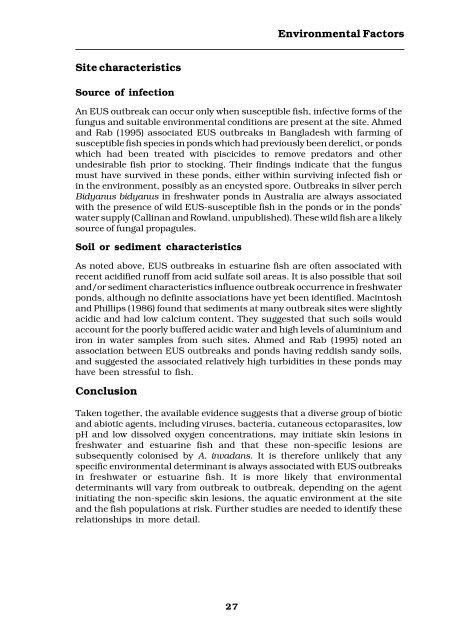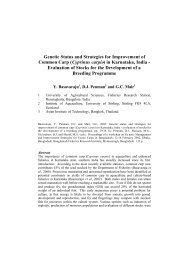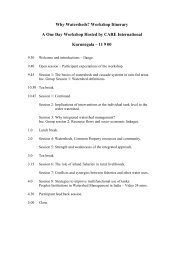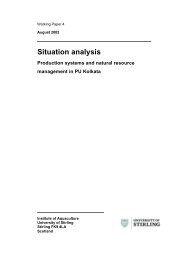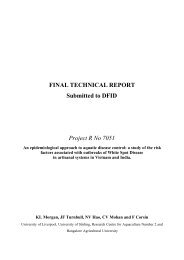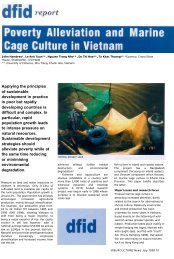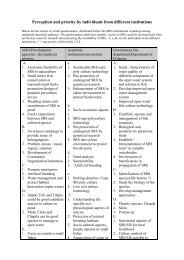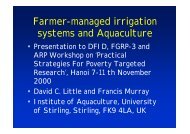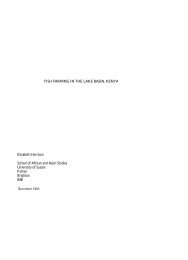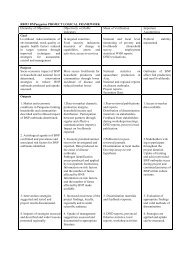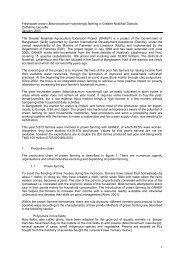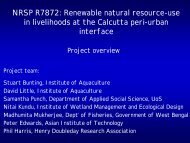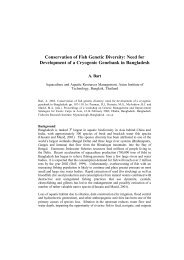Epizootic Ulcerative Syndrome (EUS) Technical Handbook
Epizootic Ulcerative Syndrome (EUS) Technical Handbook
Epizootic Ulcerative Syndrome (EUS) Technical Handbook
Create successful ePaper yourself
Turn your PDF publications into a flip-book with our unique Google optimized e-Paper software.
Environmental FactorsSite characteristicsSource of infectionAn <strong>EUS</strong> outbreak can occur only when susceptible fish, infective forms of thefungus and suitable environmental conditions are present at the site. Ahmedand Rab (1995) associated <strong>EUS</strong> outbreaks in Bangladesh with farming ofsusceptible fish species in ponds which had previously been derelict, or pondswhich had been treated with piscicides to remove predators and otherundesirable fish prior to stocking. Their findings indicate that the fungusmust have survived in these ponds, either within surviving infected fish orin the environment, possibly as an encysted spore. Outbreaks in silver perchBidyanus bidyanus in freshwater ponds in Australia are always associatedwith the presence of wild <strong>EUS</strong>-susceptible fish in the ponds or in the ponds’water supply (Callinan and Rowland, unpublished). These wild fish are a likelysource of fungal propagules.Soil or sediment characteristicsAs noted above, <strong>EUS</strong> outbreaks in estuarine fish are often associated withrecent acidified runoff from acid sulfate soil areas. It is also possible that soiland/or sediment characteristics influence outbreak occurrence in freshwaterponds, although no definite associations have yet been identified. Macintoshand Phillips (1986) found that sediments at many outbreak sites were slightlyacidic and had low calcium content. They suggested that such soils wouldaccount for the poorly buffered acidic water and high levels of aluminium andiron in water samples from such sites. Ahmed and Rab (1995) noted anassociation between <strong>EUS</strong> outbreaks and ponds having reddish sandy soils,and suggested the associated relatively high turbidities in these ponds mayhave been stressful to fish.ConclusionTaken together, the available evidence suggests that a diverse group of bioticand abiotic agents, including viruses, bacteria, cutaneous ectoparasites, lowpH and low dissolved oxygen concentrations, may initiate skin lesions infreshwater and estuarine fish and that these non-specific lesions aresubsequently colonised by A. invadans. It is therefore unlikely that anyspecific environmental determinant is always associated with <strong>EUS</strong> outbreaksin freshwater or estuarine fish. It is more likely that environmentaldeterminants will vary from outbreak to outbreak, depending on the agentinitiating the non-specific skin lesions, the aquatic environment at the siteand the fish populations at risk. Further studies are needed to identify theserelationships in more detail.27


